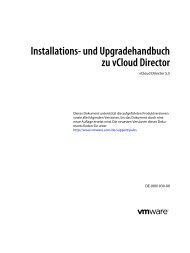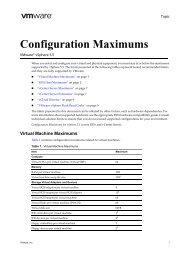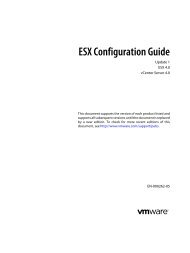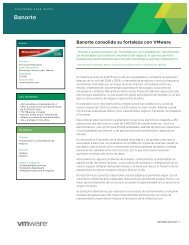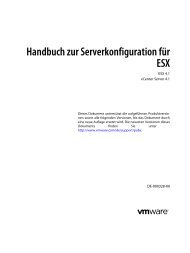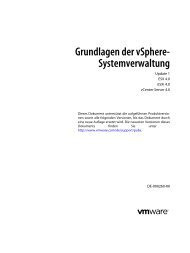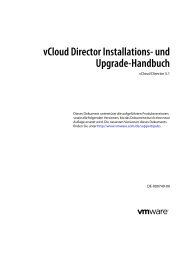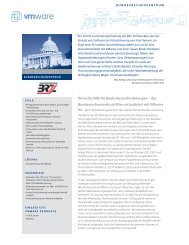Getting Started with vFabric Hyperic v.5.7 - VMware
Getting Started with vFabric Hyperic v.5.7 - VMware
Getting Started with vFabric Hyperic v.5.7 - VMware
You also want an ePaper? Increase the reach of your titles
YUMPU automatically turns print PDFs into web optimized ePapers that Google loves.
In a standard agent.properties — one that you can deploy to multiple agents that report tothe same <strong>vFabric</strong> <strong>Hyperic</strong> Server, you do not edit the properties that specify an agent's listenaddress and port. At first startup, if explicit values for IP address and port are not set, the<strong>vFabric</strong> <strong>Hyperic</strong> Agent - which detects the network interfaces on the platform - uses the firstdetected interface as its listen address, and port 2144 or 2443 as its listen port, depending onwhether you configure the agent for plain text or SSL communications.At a minimum, you must define the <strong>vFabric</strong> <strong>Hyperic</strong> Server address and port. In addition, youcan configure optional agent behaviors that are controlled by agent properties. For moreinformation, see Set Up Agent in Properties File.The first time you start the agent, it will read its properties file for the server connectioninformation, connect to the server, and register itself.Encrypted values in agent.properties fileIf your standard agent.properties contains any encrypted values, you must distributethe file that contains the encryption key, in addition to agent.properties. Theencryption key is stored in the agent.scu file in the AgentHome/conf/ directory of theagent installation where the encryption was performed. The agent.scu file must beinstalled in the same directory on each agent you deploy <strong>with</strong> the standard properties file.Perform Remote Agent InstallationsInstall and Start Agents One-by-OneFollow these steps to install agents one-by-one. To install to all target platforms at once, seeDeploy and Start Multiple Agents at Once below.3. Log on to your installation account on the install server.4. SSH to the remote platform.5. Copy the agent archive to the agent host.6. Unpack the agent archive.7. Copy the agent.properties file to the /.hq directory under the home directory ofthe standard agent installation user account.8. Start the new agent.Deploy and Start Multiple Agents at OnceFollow these step to install and start the agent on multiple hosts:1. Create a hosts.txt file on your install server that maps hostname to IP address foreach platform to which you wish to install the agent.2. Open a command shell on the install server.55




